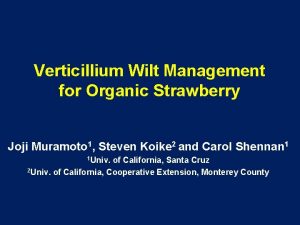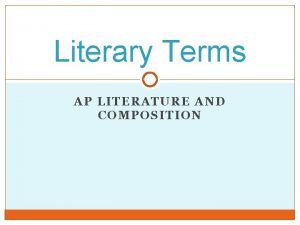Molecular Mechanisms of Gosss Wilt Samuel Eastman 1

- Slides: 1

Molecular Mechanisms of Goss’s Wilt Samuel Eastman 1, Guangyong Li 2, 3, Fan Yang 2, 3, Josh Herr 2, 3 and James R. Alfano 1, 2, 3 1 UNL Undergraduate Microbiology, 2 Center for Plant Science Innovation and 3 Department of Plant Pathology, University of Nebraska-Lincoln Abstract Clavibacter michiganensis subsp. Nebraskensis (Cmn) is a pathogen responsible for Goss’s Wilt in maize in the high plains. Strains of Clavibacter michiganensis subsp. Nebraskensis that are virulent and non-virulent in maize have been isolated, but the mechanism of this differentiation is not understood. Investigation of the genetic differences between virulent and non-virulent strains is providing an explanation as to how Cmn causes disease. Cmn mutants with reduced or removed virulence have been created using Tn 5 transposon transformation to randomly knockout virulence factors. Potential effectors have also been identified in a genomic “virulence island” region by using bioinformatics. Method of Type of Corn Location Inoculation Strain Virulence Date Inoculated Mutant Type 519 - 2/12/16 Ez. Tn 5 Mutant (2) Nick-Dab Heirloom GB GC 562 - 2/12/16 Ez. Tn 5 Mutant (2) Nick-Dab Heirloom GB GC 573 - 2/12/16 Ez. Tn 5 Mutant (2) Nick-Dab Heirloom GB GC 575 - 2/12/16 Ez. Tn 5 Mutant (2) Nick-Dab Heirloom GB GC 576 - 2/12/16 Ez. Tn 5 Mutant (2) Nick-Dab Heirloom GB GC 586 - 2/12/16 Ez. Tn 5 Mutant (2) Nick-Dab Heirloom GB GC 623 - 2/19/16 Ez. Tn 5 Mutant (2) Nick-Dab Heirloom GB GC 628 - 2/19/16 Ez. Tn 5 Mutant (2) Nick-Dab Heirloom GB GC 658 - 2/19/16 Ez. Tn 5 Mutant (2) Nick-Dab Heirloom GB GC 681 - 2/19/16 Ez. Tn 5 Mutant (2) Nick-Dab Heirloom GB GC 720 - 2/26/16 Ez. Tn 5 Mutant (2) Nick-Dab Heirloom GB GC 721 - 2/26/16 Ez. Tn 5 Mutant (2) Nick-Dab Heirloom GB GC Avirulent Mutants Out of almost 1200 Tn 5 mutants, 12 showed no virulences on maize Inoculated corn symptom comparison The severity of Goss’s Wilt symptoms was recorded in all inoculated plants. Transformed strains that caused significantly reduced or absent symptoms were flagged for analysis and further testing. Tn 5 Transposome Random Mutagenesis By transforming Cmn with a transposon carrying a selectable antibioticresistance gene, over a thousand random mutants of Cmn were created. The Tn 5 transposon inserts randomly into the genome, breaking any gene in which it lands. Goss’ Wilt Symptoms Goss’s Wilt is a vascular pathogen that causes tissue necrosis parallel to leaf veins, with characteristic spots of bacterial exudate. Yield loss due to Goss’s Wilt can reach 50% in severely infected fields. Goss’s Wilt is historically a Nebraska pathogen but the range of disease increases during hot, dry years. Method of Type of Corn Location Inoculation Strain Virulence Date Inoculated Mutant Type 511 + 2/12/16 Ez. Tn 5 Mutant (2) Nick-Dab Heirloom GB GC 512 + 2/12/16 Ez. Tn 5 Mutant (2) Nick-Dab Heirloom GB GC 513 + 2/12/16 Ez. Tn 5 Mutant (2) Nick-Dab Heirloom GB GC 514 + 2/12/16 Ez. Tn 5 Mutant (2) Nick-Dab Heirloom GB GC 515 + 2/12/16 Ez. Tn 5 Mutant (2) Nick-Dab Heirloom GB GC 516 + 2/12/16 Ez. Tn 5 Mutant (2) Nick-Dab Heirloom GB GC 517 + 2/12/16 Ez. Tn 5 Mutant (2) Nick-Dab Heirloom GB GC 518 + 2/12/16 Ez. Tn 5 Mutant (2) Nick-Dab Heirloom GB GC 519 - 2/12/16 Ez. Tn 5 Mutant (2) Nick-Dab Heirloom GB GC Clavibacter Virulence Data Virulence readings on over 1000 randomly generated mutants were taken and recorded. Potentially avirulent strains are shown in green to show reduced or absent virulence in the plant. Ctrl 451 519 566 573 575 576 Pro. ID Gene Name Character Size(bp) GC% GC Diff. (-73%) PROKKA_00090 hypothetical protein unknown 93 73. 1 0. 1% PROKKA_00133 hypothetical protein 210 79 6. 0% PROKKA_00432 Phage_integrase 1116 63. 9 -9. 1% PROKKA_00434 hypothetical protein unknown 372 65. 05 -8. 0% PROKKA_00435 hypothetical protein unknown 243 59. 25 -13. 8% PROKKA_00441 hypothetical protein unknown 408 65. 2 -7. 8% PROKKA_00442 hypothetical protein unknown 420 65. 48 -7. 5% PROKKA_01195 hypothetical protein unknown 138 73. 2 0. 2% PROKKA_01305 hypothetical protein unknown 990 51 -22. 0% PROKKA_01416 Bsu. MI modification methylase subunit Ydi. O putative Bsu. MI modification methylase subunit Ydi. O 1140 57. 63 -15. 4% PROKKA_01495 hypothetical protein unknown 120 79. 2 6. 2% PROKKA_01504 hypothetical protein unknown 183 75. 41 2. 4% PROKKA_01554 hypothetical protein unknown 156 78. 2 5. 2% PROKKA_02089 hypothetical protein unknown 246 73. 2 0. 2% PROKKA_02139 hypothetical protein unknown 117 75. 21 2. 2% PROKKA_02246 hypothetical protein unknown 312 81. 93 8. 9% PROKKA_02310 hypothetical protein unknown 135 77. 8 4. 8% PROKKA_02646 hypothetical protein unknown 294 65 -8. 0% PROKKA_02648 hypothetical protein unknown 174 67. 8 -5. 2% PROKKA_02652 hypothetical protein unknown 246 65. 9 -7. 1% PROKKA_02653 hypothetical protein unknown 402 68. 7 -4. 3% PROKKA_02654 hypothetical protein unknown 513 67. 3 -5. 7% PROKKA_02655 hypothetical protein unknown 180 65 -8. 0% PROKKA_02681 hypothetical protein unknown 99 57. 6 -15. 4% Reverse Genetics Approach By comparing the sequence of the virulent strain of Cmn to other, avirulent strains, candidate genes for potential effectors were identified. The genes in green are located clustered together with a gene for a Phage integrase protein, suggesting a region of virulence genes (a “virulence island”), responsible for the acquisition of pathogenicity and Goss’s Wilt symptoms. Gene Knockout using Homologous Recombination Using Homologous Recombination the virulence region described above and all the genes contained within will be knocked out all at once. A specially-prepared version of DNA with identical sequences from up- and down-stream of the virulence region will bind to the genomic DNA and replace the region with a selectable antibiotic marker Acknowledgements We appreciate the help of Dr. Bob Harveson and Kathy Nielson for providing heirloom Golden Bantam maize seeds and Cmn strains from their collection, of Dr. Tamra Jackson for providing many base strains of Cmn from her collection, and of Dr. Riekhof for assistance with molecular techniques. This research was supported by a UCARE grant from the University of Nebraska-Lincoln. Laboratory Setup Plants were inoculated by dabbing bacterial solution on a leaf cut. They were then kept for 1 week in a growth chamber at 24 degrees C. Strain-Specific Colony PCR By including strain-specific primers in the PCR reaction, potentially avirulent strains were either identified as arising from the original transformed strain, or identified as a contaminant.

